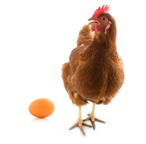 The Six Chix Project is now starting to produce some outcomes and increasing interest in Funafuti. In this post we are going to take a quick look at the statistics so far. We currently have 7 Hyline Brown hens producing our eggs, plus an assortment of other chickens. Its the Hyline hens we are focusing on here, later we will focus more on the heritage breeds we are trying to establish here for backyard production in the community.
The Six Chix Project is now starting to produce some outcomes and increasing interest in Funafuti. In this post we are going to take a quick look at the statistics so far. We currently have 7 Hyline Brown hens producing our eggs, plus an assortment of other chickens. Its the Hyline hens we are focusing on here, later we will focus more on the heritage breeds we are trying to establish here for backyard production in the community.
For the Hyline hens, the question was: could we successfully grow large fowl chickens on an atoll (in Funafuti) for egg production? What are the problems? And what kind of outputs could we get? Here is what we have found so far.
Our Hyline hens are made up of 5 hens now 31.3 weeks old plus 2 hens 26.5 weeks old. They are healthy for the most part, though we did lose one hen – probably to ant bait poisoning (unconfirmed as there is no vet in the country). We worm the girls every month using Vermex which we bring into the country for our own use. We also give the chickens a weekly feed of mash + diatomaceous earth + garlic + oregano + probiotic yoghurt starter to keep them healthy.
They are generally fed layer mash from Pacific Feeds Fiji, grass, household scraps and anything they can catch in their run. Recently we had 6 weeks without any commercial feed, and the chickens were fed anything we could find, including human food, fish, grass, starter crumbles and Millmix. That was a traumatic experience for us having to find food everyday because we do not own land here we could not rely on any local sources of food. Despite these hiccups, here are the stats for 7 layers. They are not going to compete with purely commercial and technical production, but we are pretty happy for the fresh, rich eggs we get.
- Date first egg laid = 22nd April 2015 = 11 weeks of production
- Total number of eggs to date = 324 eggs = 29.5 eggs per week
- Total weight of eggs = 17.83 kg = 1.6 kg of eggs per week
The graphs below show the trace of the number of eggs we collected on each day; the total weight of eggs collected per day; the average number of eggs/hen/day (a value of 1 would mean on that day all the hens produced an egg); and the average weight per egg produced.




Production was slow to begin with and it took about 3 weeks from the date the first hen started to lay before the rest of the same age came into production. There was some loss of production during the period I had to find food every day (see Eggs/Hen/Day graph). The average weight of eggs has been increasing and has increased from about 54g per egg to somewhere around 60g now.
In conclusion, keeping chickens for eggs on an atoll is definitely possible, and pretty rewarding too. Especially if you can buy commercial feed as a background to any local foods, scraps and grasses the chickens can get access to (see also our story Not Just Chicken Feed).
So, YES ! Eggs can be produced on atolls. Who would have thunk it?
